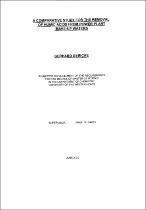| dc.description.abstract | Water treatment forms an integral part of thermal electric power generation (coal fired as well as nuclear power stations). There are generally two main water cycles associated with thermal power generation, namely the steam/water cycle that uses demin water for the production of steam and the cooling water circuit, which is used for condensing the steam back to water. The two cycles are isolated from each other and exchange heat via a condenser. Power station make up water treatment plants have traclltionally been designed to
produce water of a very high quality (free from inorganic salts) by synthetic ion exchange resins. Raw water quality (mainly TDS, OA and silica) is the key factor in the design of the plant. Any deterioration of raw water quality during the life cycle of the plant, which is currently a South African and worldwide phenomenon, will inevitably have a negative impact on treatment plant performance and plant integrity. ln order to meet the specifications of the water quality required for proper plant operation, an extra burden, as well as associated treatment costs, will therefore have to be placed on existing treatment processes to compensate for change in feed water quality. | en_US |

